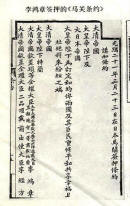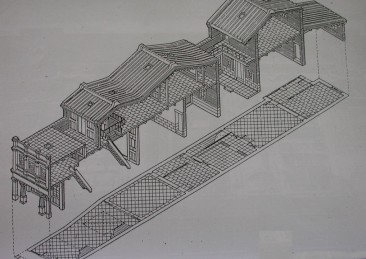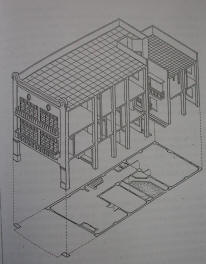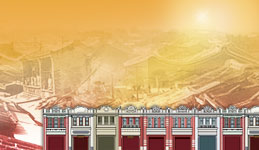|
 A New Era
A New Era
1895 A.D. the street-houses of ' No sky' street area entered another
stage—the Japanese troops were sent to Taiwan after The
Jiawu War.
As a result, a great number of immigrants moved back to the
mainland, and the population of Lukang was reduced to 20,000 people.
To consolidate their jurisdiction, the Japanese leaders introduced
the Japanese architecture to Taiwan, attempting to eliminate the
recognition held by Taiwan people for the mainland. The Japanese
Colonial Period can be divided into the following periods: |
|
 |
 |
|
Ma Guan treaty for Jiawu War |
The treaty |
 The
Initial Period
The
Initial Period
The Japanese leaders, in the name of improving public hygiene,
implemented a reconstruction program, including the widening of the
existing roads for a road network and building of a new sewer system to
improve the sanitation of Taiwan’s traditional cities. Meanwhile, the
Japanese architecture and building materials such as tatami became quite
popular, which greatly differed from the street-houses of the Ching
Dynasty. Lukang, however, was not covered in the
reconstruction program
due to the historic importance of Wu-Fu Street, which was protected by
the Japanese law. Furthermore, ' No sky' street area was even more
astounding to the Japanese people. Consequently, only a few sections of
the roofs were demolished; the earlier street-houses remained largely
intact.  TOP
TOP
|
 |
|
Street house of the initial period |
 The City Reconstruction Program
The City Reconstruction Program
The street-houses remained intact until 1934, when the Taichung County
Magistrate devoted himself to the promotion of the reconstruction
program of Lukang. With great determination, he demolished the
century-old roofs of ' No sky' street area and widened the streets,
which means that most of the facades of the street-houses were
demolished. From then on, the structure and the façade were quite
different from those built during the Ching Dynasty. The structure of
this time resembled that of the initial period as mentioned above, with
the
“Showa”-style façade, which was simpler and less fixed. The main
building materials were still bricks despite the change of façade. The
second floors of the stores were, as a rule, built from wood, which is
adopted by some stores on The Chung Shan Road (new name for ' No sky'
street area after the reconstruction program). The new western, more
modern facades were built with cement and cramp irons, which were
different from those built during the Ching Dynasty. (see Frontispiece)
|
 |
 |
|
Street house of modification |
On the modification |
|
 After the Reconstruction
After the Reconstruction
After the reconstruction program, the houses on ' No sky' street area
were different from those built during the Ching Dynasty because of the
adoption of modern styles and building materials. The thing that we have
to know to gain a better understanding of the changes of the
street-houses on ' No sky' street area is that ' No sky' street area was
designed for business activities and the stores were built to facilitate
the merchants to
run their businesses. Therefore, the first compartment
of the buildings was mostly the store and the second compartment was the
residential area, which made it easier for the customers to shop. This
rationale was followed by both the architecture of the Ching Dynasty and
the Japanese Colonial Period. The cause for the difference between the
two periods was the reconstruction program. |



